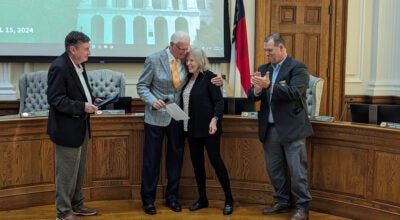Historic Salisbury Foundation will buy Blackmer House
Published 12:00 am Wednesday, June 20, 2012
By Mark Wineka
mwineka@salisburypost.com
SALISBURY — Historic Salisbury Foundation announced Wednesday it will buy the former home of the city’s most celebrated actors, the late Sidney and Suzanne Blackmer.
Susan Sides, president of the foundation, sat beside Jonathan Blackmer, son of the famed thespians, to outline a plan for the house’s preservation and what most probably will be a community-supported effort to recreate and restore one of Salisbury’s oldest structures.
“Historic Salisbury Foundation can preserve this house,” Sides promised.
Significant portions of the 1820-21 house were destroyed by a Dec. 1, 1984, fire, but Suzanne Blackmer, followed by Jonathan Blackmer, fought stubbornly through the years to keep it from being razed. At times, the non-profit Historic Salisbury Foundation and private benefactors stepped in with repairs and funds to provide some stabilization for the endangered property.
The Blackmer House is located at 112 S. Fulton St. HSF Executive Director Brian Davis said its preservation will provide an important bookend to the West Square Historic District.
Sides said Davis and a number of HSF trustees examined the house and “are in agreement that there is enough of the early fabric left in the house to be the basis for an accurate restoration and recreation of the old house.”
“We are so pleased,” Sides added, “that Mr. Blackmer has entrusted his childhood home into the hands of the foundation.”
A closing on the foundation’s purchase from Blackmer is set for July 2. Davis declined to disclose the purchase price until it becomes public record with the sale.
Blackmer will begin emptying the house of any personal belongings. He also plans a yard sale June 28-30 at the rear of the onetime residence.
“When he has completed the removal of his property,” Sides said, “the foundation will begin a cleanup of the property and a well-planned preservation study.
“We want this home to be a source of pride in the community, and we feel it will be a most interesting educational study in the preservation of a home that has stood on Fulton Street since 1820.”
Falling into disrepair
As recently as mid April, the city’s code services division manager, Chris Branham, said he would seek permission from the Historic Preservation Commission to demolish the house if Blackmer didn’t bring the structure up to minimum housing standards, sell it or demolish it himself.
Branham had received numerous complaints about the property.
Suzanne Blackmer’s insurance on the house had lapsed prior to the 1984 fire, and she could not afford to rebuild it. After the fire, she lived for a time in the garage and “really went through a lot to keep this home,” Jonathan Blackmer said.
Suzanne Blackmer eventually returned to New York City, where she gained some notoriety for taking on and prevailing against Donald Trump, the landlord who wanted her out of her rent-controlled apartment in Manhattan.
Meanwhile, the house back in Salisbury sat vacant. Suzanne Blackmer died in 2004; Sidney Blackmer, in 1973.
Home’s origin
The house’s original owner/builder was John Fulton, for whom Fulton Street and the Fulton Masonic Lodge in Salisbury are named. Noted Salisbury preservationist Ed Clement said the home has important ties to educational history in North Carolina.
A Jan. 1, 1821, advertisement from an early Salisbury newspaper, the Western Carolinian, noted the house’s construction was being finished, and it would serve as a boarding house for young ladies attending the Salisbury Academy.
“Many communities don’t have any structure that dates to the time the Fulton house was built,” Sides said. “A thought that impacts me about the age of this house is that it was built before Andrew Jackson ever served as president of the United States.”
In her own research, Sides found it interesting that John Fulton was one of the founders of the Salisbury Thespian Society, which raised money through its theatrical productions for a school academy. Later, it was fitting that Salisbury’s greatest actor, Sidney Blackmer, would buy the Fulton-built house, she said.
Sidney Blackmer bought the home in the late 1920s from the Mock family, and it became the childhood home of Jonathan Blackmer and his brother, Brewster.
Jonathan Blackmer was struck by a car on his fifth birthday in front of this house.
‘Wonderful memories’
On rainy days, the house was a great place to play hide-and-seek because it offered so many places to hide, including an expansive attic, Blackmer recalled. As a boy, he sat quietly on the front porch listening to the nighttime conversations of all the adults around him.
When he fell asleep, his father would carry him upstairs to his bedroom.
“Those are wonderful memories,” Blackmer said.
With their theatrical parents, the Blackmer children sometimes attended boarding schools or had other people looking after them, but Salisbury was always the home base, Jonathan Blackmer said.
Blackmer gave a lot of credit to his agreement with Historic Salisbury Foundation to Betty Dan Spencer. He said she is a wonderful historian whose tireless efforts over the years were directed at making sure he, nor anyone else, bulldozed the house.
Blackmer, an attorney who lives in Alexandria, Va., and who does some acting himself, didn’t have control of the property until 2004, when he inherited it from his late mother. “It was always on my mind,” he said, but he refused to label the house an albatross.
It actually was a motivating factor in his life that kept him focused on family and friends, he said.
Patience pays off
Blackmer acknowledged he was under some pressure — and attacks — from people who wanted to see the home razed, but he credited the city for being tolerant and giving him time to come up with the solution reached this week.
He also saluted many friends for helping him with the property. Blackmer said it has been “very difficult to deal with over the years,” beyond the emotional ties he has to the house.
In 2008, Blackmer himself asked and received permission from the Historic Preservation Commission to demolish the house, but the approval included a year’s grace period for preservationists to explore their options for saving it.
With the grace period long expired, Blackmer had expressed his willingness to sell the house for public use, with at least one room dedicated to his parent’s acting careers. At one point, he also estimated the cost of repairs and renovation of the house at $400,000.
Clement, who grew up in this neighborhood and personally knew the Blackmers, said the house’s significance will add tremendously to Salisbury’s credentials as a historic city. It also goes to prove something else, Clement said.
“Patience pays with preservation, because it has been a long process,” he said.
Significant portions of an open newel stairway are still intact in the Blackmer House. Clement’s John Steele House, the city’s oldest, has an almost identical stairway.
Foundation officials said cleanup and extensive research into the house’s history will come first.
What the home will be in the end — a private residence or house museum, for example — is still to be determined.
With Jonathan Blackmer’s help, Rowan Public Library plans a special exhibit on Sidney and Suzanne Blackmer this fall.
Quite a career
In one of his most memorable stage performances, Sidney Blackmer won a 1950 Tony for best actor in “Come Back, Little Sheba.” He portrayed President Teddy Roosevelt in more than a dozen films. In 1937 alone, he appeared in 12 films, including “Heidi” with Shirley Temple.
Audiences still might remember his Boss Finley role in Tennessee Williams’ “Sweet Bird of Youth” with Paul Newman, or his take on a Satan-worshipping warlock in the 1968 movie “Rosemary’s Baby.” As early as 1914, Sidney Blackmer appeared in the popular serial “The Perils of Pauline,” and he first became a star with the 1921 silent movie “The Mountain Man.”
Sidney Blackmer was instrumental in raising funds and awareness for the U.S. Muscular Dystrophy Association, serving several years as a national vice president for the organization.
An actor in at least 40 films, Suzanne Kaaren Blackmer had a part in “The Great Ziegfeld,” the Academy Award winner for best picture in 1936. She also starred with Bela Lugosi in the 1940 cult classic film “The Devil Bat” and appeared in several “Three Stooges” films.
The couple married in 1943. Born in Salisbury July 13, 1895, Sidney Blackmer was his wife’s senior by 17 years. Suzanne Blackmer would have been 100 this year.
Contact Mark Wineka at 704-797-4263.




